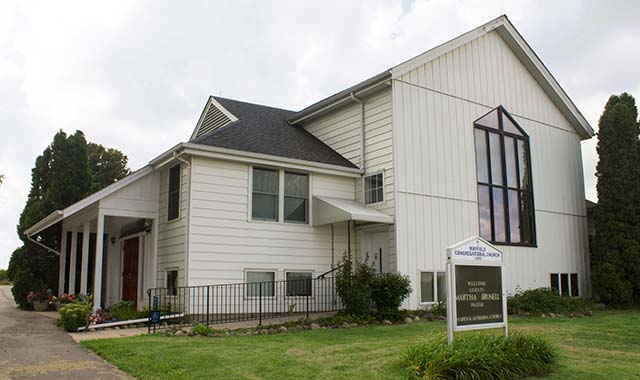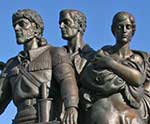Organized religion plays a major role in the settling of Illinois and continues to influence the culture of our region. We highlight two places of worship, one in the country and one in the city.
“Faith is not something to grasp; it is a state to grow into.” –Mahatma Gandhi

Country Church: Mayfield Congregational Church UCC • Est. 1860
28504 Church Road, Sycamore, mayfieldchurchucc.org
28504 Church Road, Sycamore, mayfieldchurchucc.org
This area, first settled in 1835, has undergone several name changes. It was first named Coltonville, after one of the early settlers, and then as Brush Point. In 1850, when it was officially organized as a town, it was briefly known as Liberty, reflecting the township’s anti-slavery activism. The name was changed to Mayfield a few months later.
This church began as a Wesleyan Methodist Church, participating in the Methodist Rock River Conference as a stop on the circuit starting in 1845. They met in people’s homes and the local schoolhouse until 1860, when they officially organized. The wooden frame building, still being used today, was constructed at what is now the corner of Church and Aldrich roads.
Its first pastor was a tireless advocate for abolition, and the church became a station on the Underground Railroad.
In 1906, when the church could no longer get preachers from the Wesleyan Circuit, the members changed affiliation to Congregational, and as part of the Congregational and Christian Conference of Illinois, it became Mayfield Congregational Church.
In the 1960s, the Mayfield church joined the Northern Association of Congregational Christian Churches, which eventually became part of the Illinois Conference of the United Church of Christ.
Additions have been made over the years, but the sanctuary stands just as it was built. In March 2012, some time after Sunday service, the ceiling collapsed, causing significant damage to the sanctuary and its contents. Luckily, the stained glass windows remained intact. Members held services at a facility in DeKalb until rededication of the sanctuary in February 2013.
The Rev. Martha Brunell, newly appointed pastor, leads services on Sunday at 9 a.m.

City Church: Trinity Episcopal Church • Est. 1849
218 E. Benton St., Aurora, (630) 897-7283, trinityaurora.org
This congregation was organized in 1849 with just seven members, who held services in each other’s homes and the schoolhouse. In 1851, construction for a church began on a lot at the corner of Spruce and North Lake streets, donated by Roswell Wilder in exchange for a lifetime pew.
That brick building, designed in the Gothic style, was consecrated in 1854, but by 1867, with more members living on the east side than the west side, it was decided that a larger, more central location was needed. The congregation sold the brick Gothic church to a Baptist congregation and moved temporarily to a hall on Broadway.
The present church, on the corner of Benton and Lincoln streeets, was begun in spring 1870 and held its first service in June 1871. This native limestone church was constructed in the Gothic Revival style and boasts three impressive stained glass windows in its sanctuary. A parish house was added in 1907. It’s the oldest church in Aurora still occupied by the original congregation.
The current organ was the church’s third, built by M.P. Moller in 1924 for $14,000. Following water damage in the 1970s, the instrument languished unused until 2001, when it was restored. The organ has three manual stops, 27 ranks, 20 cathedral chimes and a 61-bar harp.
Today, The Rev. Thomas Rosa, pastor, leads Sunday services at 10 a.m., followed by coffee hour and adult education.




















































